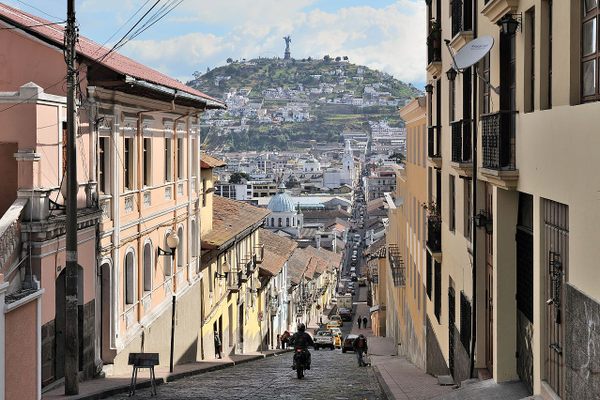Iglesia de la Compañía de Jesús
It took 160 years to complete the most ornate church in Ecuador.
Jesuit architects began work on the Iglesia de la Compañía de Jesús in 1605. The church was finally completed 160 years later, and is now considered one of the finest examples of Spanish Baroque architecture in South America.
During the 16th century, religious orders were busy building churches in the newly founded city of Quito. The colonial city council had granted plots to the Franciscans, the Augustinians, and the Dominicans, among others. And when the first Jesuit priests arrived in Quito in 1586, they too sought land in the city on which to build a church.
The Jesuits were granted a plot just off Plaza Grande in the heart of the city, and the first stone was laid in 1605 by the Italian Jesuit priest Nicolás Duran Mastrilli. And so began a 160-year construction project that would involve numerous architects, different architectural styles, and the work of some of Quito’s greatest artisans.
Upon its completion in 1765, the Iglesia de la Compañía de Jesús had incorporated four architectural styles. The predominant architectural style is Baroque, and the church has no shortage of the exuberance, fine detail, and grandeur associated with that particular style. Moorish, or Mudejar, architecture, meanwhile, is clear to see in the geometrical figures on the church’s pillars. Parts of the interior reveal the stucco decoration of the Churrigueresque style, while the Chapel of Saint Mariana de Jesús is very much Neoclassical.
Today the church is widely regarded as the finest church in Quito and one of the most ornate religious buildings in Ecuador. The large central nave is decorated almost completely with gold leaf, gilded plaster, and wooden carvings, above which are two green and gold domes in the vaulted ceiling.
Among all the architectural flourishes are 44 paintings and 56 sculptures by artists of the Quito School. The most famous of these works are the “16 Prophets” by Nicolás Javier de Goríbar, sculptures of the Holy Trinity by Bernardo de Legarda, and paintings depicting Hell and the Final Judgment at each side of the main entrance.
Other notable elements include symbols of the Sun on the main door to the church and the ceiling. The inclusion of the Sun symbol was a nod to the Inca civilization (and the Sun God Inti), possibly included as a way of encouraging the indigenous population to enter the church. This syncretism is also displayed in other parts of the church. If you look carefully, you’ll see Ecuadorian plants and indigenous faces included within the decorations on the walls and pillars.
Know Before You Go
The Iglesia de la Compañía de Jesús is located along García Moreno and Sucre in the historic center of Quito, one block to the southwest of Plaza Grande. Visiting hours for tourists are from 9:30 a.m. to 6:30 p.m. Monday to Thursday, 9:30 a.m. to 5:30 p.m. on Friday, 9:30 a.m. to 4 p.m. on Saturday and 12:30 p.m. to 4 p.m. on Sunday. The entrance fee for foreign tourists is $5. Entrance is free on the first Sunday of every month.























Follow us on Twitter to get the latest on the world's hidden wonders.
Like us on Facebook to get the latest on the world's hidden wonders.
Follow us on Twitter Like us on Facebook